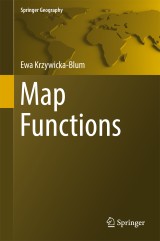Details

Map Functions
Springer Geography
|
160,49 € |
|
| Verlag: | Springer |
| Format: | |
| Veröffentl.: | 22.11.2016 |
| ISBN/EAN: | 9783319473581 |
| Sprache: | englisch |
Dieses eBook enthält ein Wasserzeichen.
Beschreibungen
<p>This book departs from typical cartography textbooks, which tend to focus on the characteristics of the methods and means of expression. Instead, it offers an explanation of the individual perspective on the map as a specific product of civilization, one that constitutes a component of social communication. </p><p>The layout highlights the essential property of cartographic notation, namely: the way of forming the map’s content elements, adjusted to its purpose. This property is ensured thanks to the dimension of reference units in relation to the observation scale of the objects, and by topological consistency between the reference units system and real layout of the objects. An exploration of the characteristics of various ways of depicting a map’s content elements, organized in the reference units dimension, is preceded by a general section accentuating the position of cartography among other sciences, as well as the definition and general properties of a map. The book’s closing chapter includes a separate textbook overview of the applications of taxonomic methods in cartography.</p>
The Phenomenon of Maps.- Elements of the Map Contents with (0D) Reference Units.- Elements of the Maps Contents with Linear (1d) Reference Units.- Elements of the Maps Contents with Surface (2d) Reference Units.- The Synthetic Structural Characteristics Determining the Qualificational Areas Division.<p></p><p></p><p></p>
<p>This book departs from typical cartography textbooks, which tend to focus on the characteristics of the methods and means of expression. Instead, it offers an explanation of the individual perspective on the map as a specific product of civilization, one that constitutes a component of social communication. </p><p>The layout highlights the essential property of cartographic notation, namely: the way of forming the map’s content elements, adjusted to its purpose. This property is ensured thanks to the dimension of reference units in relation to the observation scale of the objects, and by topological consistency between the reference units system and real layout of the objects. An exploration of the characteristics of various ways of depicting a map’s content elements, organized in the reference units dimension, is preceded by a general section accentuating the position of cartography among other sciences, as well as the definition and general properties of a map. The book’s closing chapter includes a separate textbook overview of the applications of taxonomic methods in cartography.</p>
Offers a thorough and comprehensive overview of map functions organized in the reference units dimension, pursuing an innovative approach to geovisualization Presents well-tailored sample maps at the regional, European, and global scale Includes a closing chapter on the applications of taxonomic methods in cartography, which addresses a gap in cartography literature and offers remedies to numerous misapprehensions regarding the practical implementations Includes supplementary material: sn.pub/extras
Diese Produkte könnten Sie auch interessieren:

Observing Systems for Atmospheric Composition

von: Guido Visconti, Pietro Di Carlo, W. Brune, M. Schoeberl, Andreas Wahner

149,79 €















